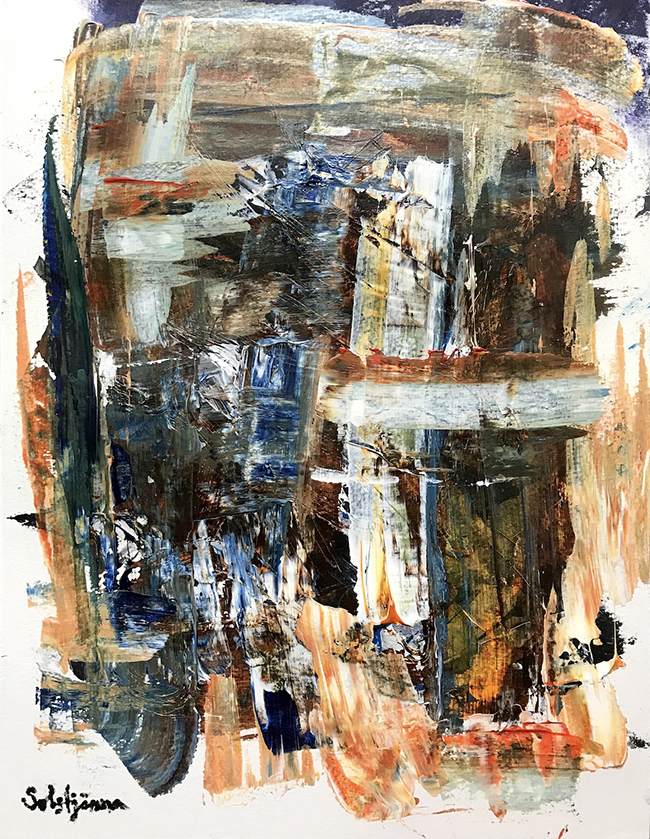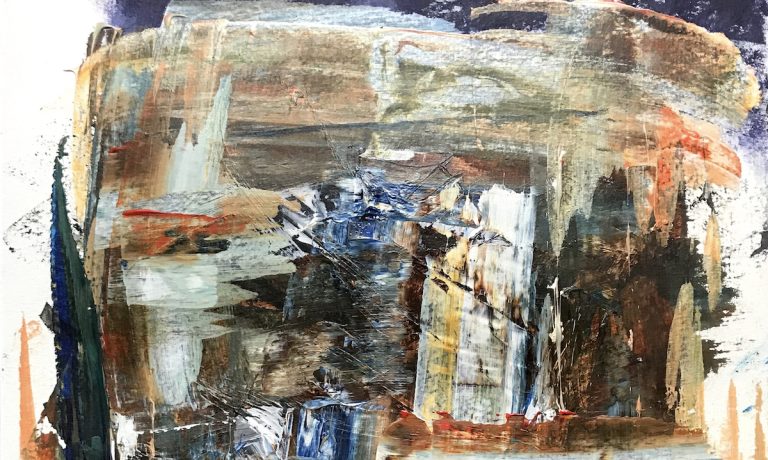Richard Solstjärna is a Swedish abstract painter based in Berlin. His work isn’t just visual—it feels like a transmission. He’s not trying to map out the world around him. He’s trying to map the world inside. His paintings are raw, physical expressions of thought, emotion, and spirit. You don’t stand in front of his work to “figure it out.” You stand there to feel it.

Solstjärna’s life has taken him through Europe, New York, and Odessa, painting, exhibiting, and absorbing the tension and beauty of different places. His process is direct. He doesn’t plan much. He lets the paint move as it wants to. The result is often bold, layered, and full of questions. It’s less about answers and more about presence—what it means to be alive, conflicted, hopeful, scared, and searching. Each piece is an emotional field. And none more so than The Pursuit Of Happiness 001.
Finished in November 2023, this acrylic work on artist paper measures 39 x 30 cm. Small in size, maybe, but it carries weight. The title came after the painting was done. Solstjärna had stepped back, looked at what he’d made, and the words landed: The Pursuit of Happiness. It surprised him. But it fit.
The painting pulses. There’s motion in it—like something has just happened or is about to. A charge runs through it, both inviting and unsettling. Solstjärna describes it as a “powerful force of nature,” something with a double edge. Attraction and danger. Promise and uncertainty. And that’s the point. Happiness isn’t simple. It draws us in, but it also asks us to risk something.
There’s a kind of psychological tension in the piece. You feel it rather than understand it. The forms don’t resolve. The energy feels like it’s pushing, pulling, trying to break through. But that pressure—that intensity—is what gives the painting its voice. It’s not polite. It’s not trying to be decorative. It’s trying to be true.
Solstjärna says painting is physical for him. And you can tell. His work doesn’t feel distant or overthought. It feels like it came out in one breath—fast, honest, and a little raw. In The Pursuit Of Happiness 001, you can feel the urgency behind the brushwork, like something needed to get out before it could be explained. But even after it’s out, there’s still mystery left behind.
The idea of “promise” sits quietly in the piece. Not a guarantee, but a suggestion. A question mark. What does happiness mean? What do we think we’re chasing when we chase it? Is it freedom? Security? A moment of peace? The painting doesn’t give a clean answer. But it reflects back the need that drives the question. The need to find something real.
There’s something universal in that. Whether or not we talk about it, everyone is in some kind of pursuit. Solstjärna turns that pursuit into paint—dense, vibrant, unstable. He’s not offering conclusions. He’s holding up a mirror.
And that’s what makes the piece work. It’s not just about his pursuit of happiness. It becomes yours, too. Your hopes, your fear of failure, your longing for meaning—whatever you bring to it shows up on the surface. The painting meets you where you are. Then it stays with you.
Richard Solstjärna doesn’t make paintings to please. He makes them to connect. And not in a surface way. His work is about what lives underneath: the push and pull of being human, the weight of hope, the raw edge of feeling. The Pursuit Of Happiness 001 captures that beautifully. It doesn’t shout. It doesn’t beg. It just pulses with life—and waits for you to feel it.

